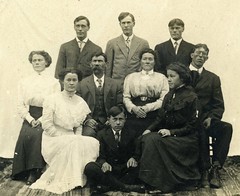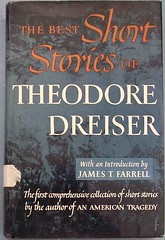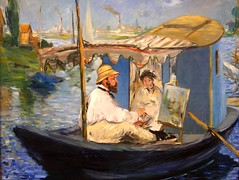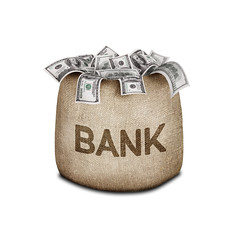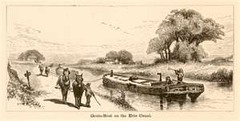| 8410360951 | nation's first big business | Railroads created a nationwide market for goods. This encouraged mass production, mass consumption, and economic specialization. (p. 320) |  | 0 |
| 8410360952 | Cornelius Vanderbilt | He merged local railroads into the New York Central Railroad, which ran from New York City to Chicago. (p. 320) |  | 1 |
| 8410360953 | Eastern Trunk Lines | In the early days of the railroads, from the 1830s to the 1860s, railroad lines in the east were different incompatible sizes which created inefficiencies. (p. 320) |  | 2 |
| 8410360954 | transcontinental railroads | During the Civil War, Congress authorized land grants and loans for the building of the first transcontinenal railroad. Two new companies were formed to share the task of building the railroad. The Union Pacific started in Omaha, Nebraska, and the Central Pacific started in Sacramento, California. On May 10, 1869, at Promontory Point, Utah, a golden spike was driven into the rail ties to mark the completion of the railroad. (p. 321) |  | 3 |
| 8410360955 | Union Pacific and Central Pacific | Two railroad companies, one starting in Sacramento, California and the other in Omaha, Nebraska were completed in Utah in 1869 to create the first first transcontinental railroad. (p. 321) |  | 4 |
| 8410360956 | American Railroad Association | In 1883, this organization divided the country into four different time zones, which would become the standard time for all Americans. (p. 320) |  | 5 |
| 8410360957 | railroads and time zones | The United States was divided into four time zones by the railroad industry. (p. 320) |  | 6 |
| 8410360958 | speculation and overbuilding | In the 1870s and 1880s railroad owners overbuilt. This often happens during speculative bubbles, created by exciting new technology. (p. 321) |  | 7 |
| 8410360959 | Jay Gould, watering stock | Entered railroad business for quick profits. He would sell off assets inflate the value of a corporation's assets and profits before selling its stock to the public. (p. 321) |  | 8 |
| 8410360960 | rebates and pools | In a scramble to survive, railroads offered rebates (discounts) to favored shippers, while charging exorbitant freight rates to smaller customers. They also created secret agreements with competing railroads to fix rates and share traffic. (p. 321) |  | 9 |
| 8410360961 | bankruptcy of railroads | A financial panic in 1893 forced a quarter of all railroads into bankruptcy. J.P. Morgan and other bankers moved in to take control of bankrupt railroads and consolidate them. (p.321) |  | 10 |
| 8410360962 | Panic of 1893 | In 1893, this financial panic led to the consolidation of the railroad industry. (p. 321) |  | 11 |
| 8410360963 | causes of industrial growth | After the Civil War, a "second Industrial Revolution" because of an increase in steel production, petroleum, electrical power, and industrial machinery. (p. 323) |  | 12 |
| 8410360964 | Andrew Carnegie | A Scottish emigrant, in the 1870s he started manufacturing steel in Pittsburgh. His strategy was to control every stage of the manufacturing process from mining the raw materials to transporting the finished product. His company Carnegie Steel became the world's largest steel company. (p. 323) |  | 13 |
| 8410360965 | vertical integration | A business strategy by which a company would control all aspects of a product from raw material mining to transporting the finished product. Pioneered by Andrew Carnegie. (p. 323) |  | 14 |
| 8410360966 | U.S. Steel | In 1900, Andrew Carnegie sold Carnegie Steel to a group headed by J. P. Morgan. They formed this company, which was the largest enterprise in the world, employing 168,000 people, and controlling more than three-fifths of the nation's steel business. (p. 323) |  | 15 |
| 8410360967 | John D. Rockefeller | He started Standard Oil in 1863. By 1881, Standard Oil Trust controlled 90 percent of the oil refinery business. His companies produced kerosene, which was used primarily for lighting at the time. The trust that he created consisted of various acquired companies, all managed by a board of trustees he controlled. (p. 323) |  | 16 |
| 8410360968 | horizontal integration | Buying companies out and combining the former competitors under one organization. This strategy was used by John D. Rockefeller to build Standard Oil Trust. (p. 323) |  | 17 |
| 8410360969 | Standard Oil Trust | In 1881, the name of John D. Rockefeller's company, which controlled 90 percent of the oil refinery business in the United States. (p. 323) |  | 18 |
| 8410360970 | interlocking directorates | The term for the same directors running competing companies. (p. 322) |  | 19 |
| 8410360971 | J. P. Morgan | A banker who took control and consolidated bankrupt railroads in the Panic of 1893. In 1900, he led a group in the purchase of Carnegie Steel, which became U.S. Steel. (p. 321, 323) | 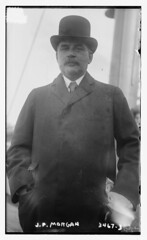 | 20 |
| 8410360972 | leading industrial power | By 1900, the United States was the leading industrial power in the world, manufacturing more than an of its rivals, Great Britain, France, or Germany. (p. 319) |  | 21 |
| 8410360973 | Second Industrial Revolution | The term for the industrial revolution after the Civil War. In the early part of the 19th century producing textiles, clothing, and leather goods was the first part of this revolution. After the Civil War, this second revolution featured increased production of steel, petroleum, electric power, and industrial machinery. (p. 323) |  | 22 |
| 8410360974 | Bessemer process | In the 1850s, Henry Bessemer discovered this process. By blasting air through molten iron you could produce high-quality steel. (p. 323) |  | 23 |
| 8410360975 | transatlantic cable | In 1866, Cyrus W. Field's invention allowed messages to be sent across the oceans. (p. 325) |  | 24 |
| 8410360976 | Alexander Graham Bell | In 1876, he invented the telephone. (p. 325) |  | 25 |
| 8410360977 | Thomas Edison | Possibly the greatest inventor of the 19th century. He established the first modern research labratory, which produced more than a thousand patented inventions. These include the phonograph, first practical electric light bulb, dynamo for electric power generation, mimeograph machine, and a motion picture camera. (p. 326) |  | 26 |
| 8410360978 | Menlo Park Research Lab | The first modern research laboratory, created in 1876, by Thomas Edison in Menlo Park, New Jersey. (p. 326) |  | 27 |
| 8410360979 | electric power, lighting | In 1885, George Westinghouse produced a transformer for producing high-voltage alternating current, which made possible the lighting of cities, electric streetcars, subways, electrically powered machinery, and appliances. (p. 326) |  | 28 |
| 8410360980 | George Westinghouse | He held more than 400 patents. He invented the high-voltage alternating current transformer, which made possible the nationwide electrial power system. (p. 326) |  | 29 |
| 8410360981 | Eastman's Kodak camera | In 1888, George Eastman invented the camera. (p. 325) |  | 30 |
| 8410360982 | large department stores | R.H. Macy and Marshall Field made these stores the place to shop in urban centers. (p. 326) |  | 31 |
| 8410360983 | R.H. Macy | He created a New York department store. (p. 326) |  | 32 |
| 8410360984 | mail-order companies | Two companies, Sears Roebuck, and Montgomery Ward, used the improved rail system to ship to rural customers to sell many different products. The products were ordered by mail from a thick paper catalog. (p. 326) |  | 33 |
| 8410360985 | Sears-Roebuck | Mail order company that used the improved rail system to ship to rural customers. (p. 326) |  | 34 |
| 8410360986 | packaged foods | Brand name foods created by Kellogg and Post became common items in American homes. (p. 326) |  | 35 |
| 8410360987 | refrigeration; canning | These developments in the food industry changed American eating habits. (p. 326) |  | 36 |
| 8410360988 | Gustavus Swift | He changed American eating habits by making mass-produced meat and vegetable products. (p. 326) |  | 37 |
| 8410360989 | advertising | This new technique was important to creating the new consumer economy. (p. 326) |  | 38 |
| 8410360990 | consumer economy | Advertizing and new marketing techniques created a new economy. (p. 326) |  | 39 |
| 8410360991 | federal land grants and loans | The federal government provided land and loans to the railroad companies in order to encourage expansion of the railroads. (p. 320) |  | 40 |
| 8410360992 | fraud and corruption, Credit Mobilier | Insiders used construction companies to bribe government officials and make huge profits. (p. 321) |  | 41 |
| 8410360993 | Interstate Commerce Act of 1886 | This act, created in 1886, did little to regulate the railroads. (p. 322) |  | 42 |
| 8410360994 | anti-trust movement | Middle class people feared a growth of new wealth due to the trusts. In the 1880s trust came under widespread scrutiny and attack. In 1890, the Sherman Antitrust Act was passed, but it was too vaguely worded to stop the development of trusts. Not until the Progressive era, would the trusts be controlled. (p. 324) |  | 43 |
| 8410360995 | Sherman Antitrust Act of 1890 | In 1890, Congress passed this act, which prohibited any "contract, combination, in the form of trust or otherwise, or conspiracy in restraint of trade or commerce." The U.S. Department of Justice secured few convictions until the law was strenghted during the Progressive era. (p. 324) |  | 44 |
| 8410360996 | federal courts, U.S. v. E.C. Knight | In 1895, the Supreme Court ruled that the Sherman Antitrust Act could be applied only to commerce, not manufacturing. (p. 324) |  | 45 |
| 8410360997 | causes of labor discontent | Worker's discontent was caused by performing monotonous task required completion within a certain time, dangerous working conditions, and exposure to chemicals and pollutants. (p. 328) |  | 46 |
| 8410360998 | iron law of wages | David Ricardo developed this theory which stated that low wages were justified. He argued that raising wages would only increase the working population, the availability of more workers would cause wages to fall, thus creating a cycle of misery. (p. 327) |  | 47 |
| 8410360999 | anti-union tactics | Employers used the following tactics to defeat unions: the lockouts (closing the factory), blacklists (lists circulated among employers), yellow dog contracts (contracts that forbade unions), private guards to quell strikes, and court injunctions against strikes. (p. 329) |  | 48 |
| 8410361000 | railroad strike of 1877 | In 1887, this strike spread across much of the nation and shut down two-thirds of the country's railroads. An additional 500,000 workers from other industries joined the strike. The president used federal troops to end the violence, but more than 100 people had died in the violence. (p. 329) |  | 49 |
| 8410361001 | Knights of Labor | Started in 1869 as a secret national labor union. It reached a peak of 730,000 members. (p. 330) |  | 50 |
| 8410361002 | Haymarket bombing | On May 4, 1886 workers held a protest in which seven police officers were killed by a protester's bomb. (p. 330) |  | 51 |
| 8410361003 | American Federation of Labor | The labor union focused on just higher wages and improved working conditions. By 1901 they had one million members. (p. 330) |  | 52 |
| 8410361004 | Samuel Gompers | He led the American Federation of Labor until 1924. (p. 330) |  | 53 |
| 8410361005 | Pullman Stike | In 1894, workers at Pullman went on strike. The American Railroad Union supported them when they refused to transport Pullman rail cars. The federal government broke the strike. (p. 331) |  | 54 |
| 8410361006 | Eugene Debs | The American Railroad Union leader, who supported the Pullman workers. The government broke the strike and he was sent to jail for six months. (p. 331) |  | 55 |
| 8410361007 | railroad workers: Chinese, Irish, veterans | In the construction of the first transcontinental railroad, the Union Pacific, starting in Omaha, employed thousands of war veterans and Irish immigrants. The Central Pacific, starting from Sacramento, included 6,000 Chinese immigrants among their workers. (p. 321) |  | 56 |
| 8410361008 | old rich vs. new rich | The trusts came under widespread scrutiny and attack in the 1880s, urban elites (old rich) resented the increasing influence of the new rich. (p. 324) | 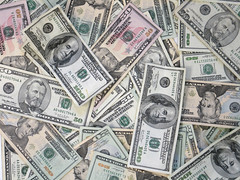 | 57 |
| 8410361009 | white-collar workers | The growth of large corporation required thousands of white-collar workers (jobs not involving manual labor) to fill the highly organized administrative structures. (p. 327) |  | 58 |
| 8410361010 | expanding middle class | Industrialization helped expand the middle class by creating jobs for accountants, clerical workers, and salespeople. The increase in the number of good-paying jobs after the Civil War significantly increased the size of the middle class. (p. 327) |  | 59 |
| 8410361011 | factory wage earners | By 1900, two-thirds of all working Americans worked for wages, usually at jobs that required them to work ten hours a day, six days a week.(p. 327) |  | 60 |
| 8410361012 | women and children factory workers | By 1900, 20 percent of adult woman working for wages in the labor force. Most were young and single women, only 5 percent of married women worked outside the home. (p. 327) |  | 61 |
| 8410361013 | women clerical workers | As the demand for clerical workers increased, women moved into formerly male occupations as secretaries, bookkeepers, typists, and telephone operators. (p. 328) |  | 62 |
| 8410361014 | Protestant work ethic | The believe that hard work and material success are signs of God's favor. (p. 325) |  | 63 |
| 8410361015 | Adam Smith | In 1776, this economist wrote "The Wealth of Nations" which argued that business should not be regulated by government, but by the "invisible hand" (impersonal econmic forces). (p. 324) |  | 64 |
| 8410361016 | laissez-faire Capitalism | In the late 19th century, american industrialists supported the theory of no government intervention in the economy, even as they accepted high tariffs and federal subsidies. (p. 324) |  | 65 |
| 8410361017 | concentration of wealth | By the 1890s, the richest 10 percent of the U.S. population controlled 90 percent of the nation's wealth. (p. 326) |  | 66 |
| 8410361018 | Social Darwinism | The belief that government's helping poor people weakened the evolution of the species by preserving the unfit. (p. 324) |  | 67 |
| 8410361019 | William Graham Sumner | An English social philosopher, he argued for Social Darwism, the belief that Darwin's ideas of natural slection and survival of the fittest should be applied to the marketpalce and society. (p. 324) |  | 68 |
| 8410361020 | survival of the fittest | The belief that Charles Darwin's ideas of natural selection in nature applied to the economic marketplace. (p. 324) |  | 69 |
| 8410361021 | Gospel of Wealth | Some Americans thought religion ideas justified the great wealth of successful industrialists. (p. 325) |  | 70 |
| 8410361022 | Horatio Alger Stories self-made man | His novels portrayed young men who became wealth through honesty, hard work and a little luck. In reality these rags to riches stories were somewhat rare. (p. 327) |  | 71 |





























